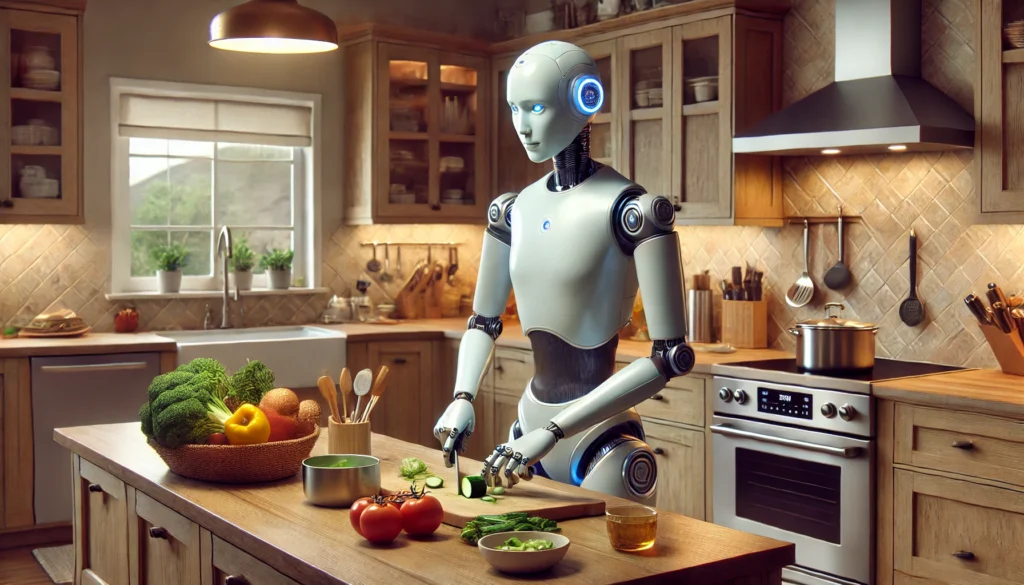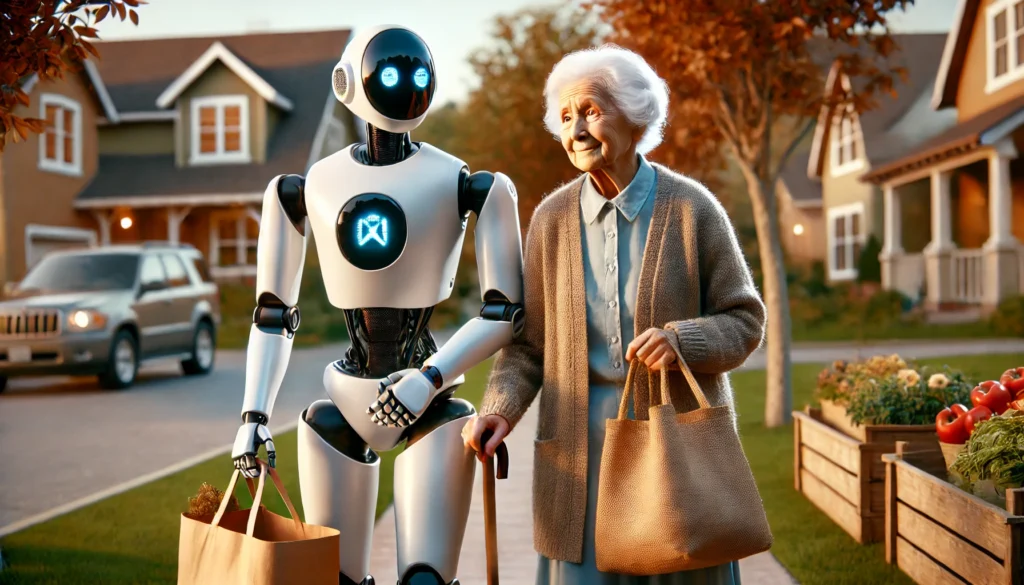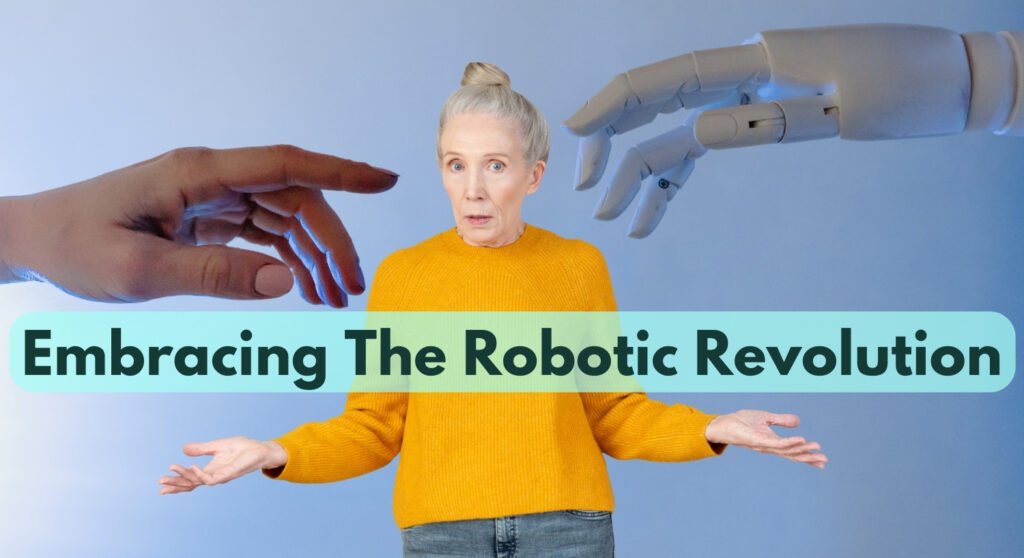Your Home Robot Helper is Coming… Sooner Than You Think!

Last Updated on June 27, 2025 by Julian Espinosa
Picture this: you wake up, and while you’re enjoying your morning coffee, a helpful robot companion is already tidying up the living room and preparing your breakfast. Sound like science fiction? Think again. The era of personal home robots designed specifically for mature adults is rapidly approaching, with remarkable developments happening right now in 2025.
Socially assistive robots are estimated to account for 30% of the eldercare robotics industry between 2025 and 2035, rising to 35% in 2035, representing a massive shift toward technology that truly understands and supports seniors’ needs. These aren’t just fancy gadgets—they’re thoughtfully designed companions that can help with daily tasks, provide medication reminders, offer engaging conversation, and even play games with you.
What makes today’s robot helpers different from previous generations is their focus on enhancing independence rather than replacing human connection. Modern robotic assistants can help with daily duties including cleaning, cooking, and medication reminders, equipped with sensors and cameras to help them navigate the house and complete duties. But perhaps more importantly, they’re designed to reduce loneliness and provide companionship when family members can’t be present.
From companies like Tesla pushing the boundaries with their Optimus robot to specialized eldercare robots already being tested in communities worldwide, the future is arriving faster than many expected. The key question isn’t whether these robot helpers will become part of our homes—it’s how quickly they’ll become as common as smartphones are today.
Ready to discover what your robot helper might look like and how it could transform your daily routine?
Why Robot Helpers Are Perfect for Today’s Seniors
You’ve lived through incredible technological changes—from rotary phones to smartphones, from handwritten letters to instant messaging. Now, the next wave of innovation is focused on making your daily life easier and more enjoyable through intelligent robot companions.
Robotic companions and assistants are designed to provide not just physical assistance but also emotional support and companionship. These aren’t cold, mechanical devices—they’re warm, interactive helpers that learn your preferences and adapt to your routines.
Think about the possibilities: a robot that remembers you prefer your morning coffee at exactly 7:30 AM, knows your favorite music for afternoon relaxation, and can even engage you in stimulating conversation about topics that interest you most. Modern robots don’t just deliver items or act as call buttons—they interact, keep people company, and even play games like BINGO.
What Can Your Future Robot Helper Actually Do?
Daily Living Support
Today’s advanced robot helpers are being designed with seniors’ specific needs in mind. They can assist with:
- Household tasks: Light cleaning, organizing, and maintaining your living space
- Meal preparation: From simple snacks to helping with more complex cooking tasks
- Medication management: Gentle reminders and organization of your daily medications
- Mobility assistance: Help with balance and support when moving around your home
Companionship and Engagement
Perhaps the most exciting development is how these robots are programmed to be genuine companions. They can:
- Engage in meaningful conversations about your interests
- Play games, from card games to trivia
- Share news and weather updates in a personalized way
- Provide gentle encouragement for staying active and engaged
Health and Safety Monitoring
Modern robot helpers serve as discrete guardians, offering:
- Fall detection and emergency response capabilities
- Health monitoring through simple, non-invasive sensors
- Connection to family members or healthcare providers when needed
- Reminders for appointments and important activities
The Technology Behind Your Future Helper
The Rise of Tesla Optimus has marked a transformative moment in the robotics and automation industry, representing significant technological progress with potential implications across various market sectors. Companies like Tesla and Boston Dynamics aren’t just creating industrial robots—they’re developing technology that will eventually find its way into our homes.
What makes 2025 different from previous years is the convergence of several technologies:
- Advanced AI: Robots can now understand context, learn from interactions, and make intelligent decisions
- Improved sensors: Better navigation and object recognition mean safer, more reliable assistance
- Natural language processing: Conversations feel more natural and engaging
- Emotional intelligence: Robots are being programmed to recognize and respond to human emotions
Real-World Examples Already Making a Difference
Researchers at the Karlsruhe Institute of Technology have been developing humanoid robots designed to improve the quality of seniors’ lives by enabling greater independence. These aren’t theoretical projects—they’re practical applications being tested and refined right now.
In assisted living communities around the world, robot companions are already:
- Leading group activities and games
- Providing personalized health reminders
- Offering 24/7 companionship for those who feel isolated
- Assisting with daily tasks while maintaining residents’ dignity and independence
Addressing Common Concerns
“Will Robots Replace Human Care?”
Absolutely not. The goal of robot helpers is to supplement, not replace, human interaction. They’re designed to handle routine tasks so that when family, friends, or caregivers visit, the time can be spent on meaningful connection rather than mundane chores.
“Are They Too Complicated to Use?”
Modern robot helpers are being designed with simplicity in mind. Voice commands, simple gestures, and intuitive interfaces make them as easy to use as talking to a helpful neighbor.
“What About Privacy?”
Leading manufacturers are prioritizing privacy and security, ensuring that your personal information stays protected while still allowing the robot to provide personalized assistance.
The Timeline: When Will They Arrive?
While we’re not quite at the point where you can order a robot helper online today, the timeline is shorter than you might think. Industry experts predict that eldercare assistive robots will see significant growth between 2025 and 2035, with early adopters potentially seeing options within the next 2-3 years.
The current focus is on making these robots affordable, reliable, and truly helpful rather than just impressive demonstrations. Companies are learning that seniors want practical assistance, not flashy features that don’t add real value to daily life.
Preparing for Your Robot Helper
Start Small, Think Big
You don’t need to wait for a full humanoid robot to start benefiting from robotic assistance. Consider starting with:
- Smart home devices that respond to voice commands
- Automated medication dispensers
- Simple robotic vacuums designed for easy use
- Video calling devices that keep you connected with family
Stay Informed and Open-Minded
Technology moves quickly, but you don’t have to keep up with every development. Focus on understanding how these tools can genuinely improve your daily life and independence.
Consider Your Specific Needs
Think about which daily tasks you’d most appreciate help with. Whether it’s mobility support, household maintenance, or companionship, knowing your priorities will help you make informed decisions when robot helpers become widely available.
The Bigger Picture: Independence and Quality of Life
The field of geriatrics is focusing on redefining aging using positive terminology and avoiding derogatory concepts. Robot helpers represent this positive approach—they’re tools for empowerment, not indicators of decline.
These technologies are being developed with the understanding that today’s seniors are active, engaged, and interested in maintaining their independence for as long as possible. Your robot helper won’t be a sign that you need “help”—it will be a smart assistant that frees you to focus on the activities and relationships that matter most to you.
Looking Ahead: A Partnership, Not a Replacement
The future of home robot helpers isn’t about replacing human connection or independence—it’s about enhancing both. Imagine having more energy for the activities you love because routine tasks are handled automatically. Picture staying in your own home longer because you have reliable assistance whenever you need it.
The three main reasons robots have been developed for seniors are: to aid with small tasks, help with mobility and transport, and reduce loneliness through social interaction. These goals align perfectly with what most mature adults want: to maintain their independence, stay active, and remain connected to their communities.

From Chores to Chat: Your Robot Helper Awaits
Here is a fascinating presentation on the progress being made in this field: AI Robots: When Will They Be in Our Homes? – IEEE Spectrum
While your personal robot companion may still be a few years away, the technology ecosystem that will support it is developing rapidly. Smart home devices, health monitoring systems, and AI assistants are all stepping stones toward the comprehensive robot helpers of tomorrow.
The most exciting part? You won’t need to become a technology expert to benefit from these advances. The best robot helpers will be the ones that adapt to you, not the other way around.
Are you excited about the possibility of having a robot helper in your home? What daily tasks would you most want assistance with—household chores, companionship, health monitoring, or something else entirely? Share your thoughts in the comments below—we’d love to hear what aspects of robot assistance appeal to you most!
And if you want to see how robotics are already helping in the home, you’ll enjoy reading this post…
FAQ: Robot Helper
- How much will a home robot helper cost?
- While current estimates vary widely, industry experts predict that basic robot helpers will likely start around $20,000-$30,000 when they first become available to consumers, with prices dropping significantly as the technology becomes more widespread. Many companies are working toward a target price point closer to that of a new car rather than a luxury item.
- Will robot helpers work in smaller homes or apartments?
- Yes! Modern robot helpers are being designed to navigate various living spaces efficiently. Advanced sensors and mapping technology allow them to work effectively in both spacious homes and compact apartments, adapting their movement patterns to your specific floor plan.
- How do robot helpers handle emergencies?
- Today’s robot helpers are equipped with emergency detection systems that can identify falls, medical emergencies, or unusual patterns in your daily routine. They can immediately contact emergency services, family members, or healthcare providers, and provide first aid guidance while help is on the way.
- Can robot helpers learn my personal preferences?
- Absolutely! Modern AI allows robot helpers to learn your daily routines, preferences for temperature, lighting, music, and even conversation topics. They adapt their assistance style to match your personality and needs, becoming more helpful over time.
- What happens if the robot breaks down or malfunctions?
- Reputable robot helper companies are developing comprehensive support systems including remote diagnostics, local repair services, and backup units to ensure minimal disruption. Many will offer service plans similar to those for major appliances.
- Are robot helpers safe around pets?
- Yes, modern robot helpers are equipped with advanced sensors that detect and avoid pets, ensuring safe coexistence. Many are even programmed to recognize and interact appropriately with common household pets.
- Do I need special internet or technical setup?
- Most robot helpers will require a stable internet connection for updates and some features, but manufacturers are designing them to work with standard home internet. Professional setup services will likely be available to ensure everything works smoothly from day one.
References
- Future Market Insights – Eldercare Assistive Robots Market Size, Trends 2025-2035
- ScienceDirect – New technologies and assistive robotics for elderly: A review on psychological variables
- PMC – Robots for Elderly Care: Review, Multi-Criteria Optimization Model and Qualitative Case Study
- MIT Technology Review – Inside Japan’s long experiment in automating elder care
- Time Magazine – Stop Me if You’ve Heard This One: A Robot and a Team of Irish Scientists Walk Into a Senior Living Home
- SlashDev – Robotics Trends In 2025 – Tesla Optimus, Figure AI, Boston Dynamics & UBTECH
- ZEISS Corporate – Digital health: how robots support care
- Lottie Care Collective – 9 Ways Robots Could Help Elderly People





